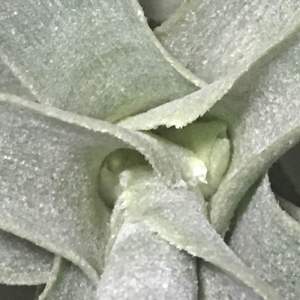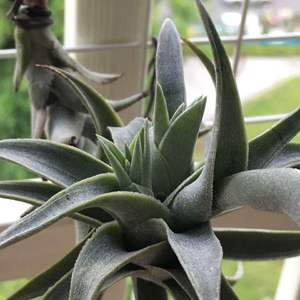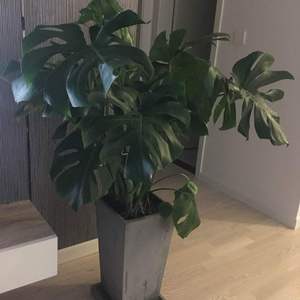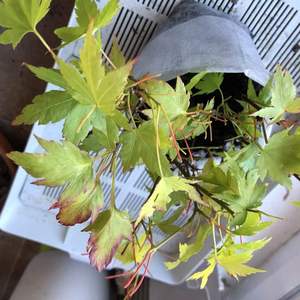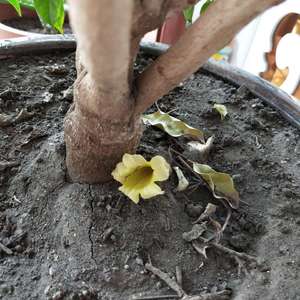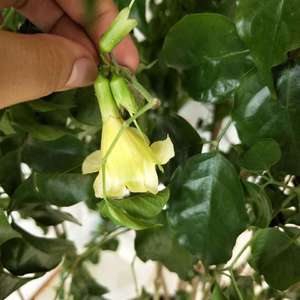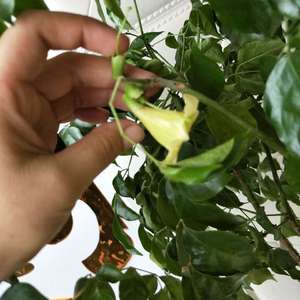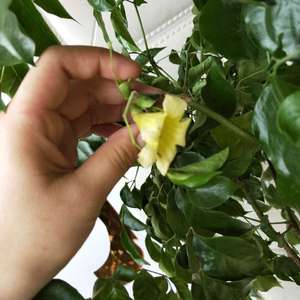文章
Miss Chen
2018年07月11日

Description: This herbaceous perennial plant is 2-6' tall and unbranched, except sometimes toward the apex, where the flowers occur. The central stem is relative stout, pale green, terete, and usually short-pubescent (less often glabrous). The opposite leaves are up to 8" long and 3½" wide, broadly oblong in shape, and smooth along their margins. The upper leaf surface is pale-medium to dark green and hairless above, while the lower leaf surface is densely covered with woolly hairs that are very short. There is a prominent central vein along the length of each leaf, and finer side veins that radiate outward toward the smooth margins. When either the central stem or leaves are torn, a milky sap oozes out that has variable toxicity in the form of cardiac glycosides.
Umbels of flowers, each about 2½-4" across, emerge from the axils of the upper leaves. These flowers are quite fragrant, with a scent resembling violets or pansies, and they range in color from faded light pink to reddish purple. Each flower is about ¼" across, consisting of 5 reflexed petals and 5 raised hoods with curved horns. The hoods are more light-colored than the petals. The pedicels of the flowers are light green to pale red and hairy. The blooming period lasts about 1-1½ months from early to mid-summer. The seedpods (follicles) are 3-4" long, broadly lanceoloid, and covered with soft prickles and short woolly hairs. At maturity, each seedpod split along one side to release numerous seeds that have large tufts of white hair. Dispersion of seed is by wind. The root system has long creeping rhizomes, promoting the vegetative spread of this plant.

Cultivation: The preference is full sun, rich loamy soil, and mesic conditions, but this robust plant can tolerate a variety of situations, including partial sun and a high clay or sand content in the soil. Under ideal conditions, Common Milkweed can become 6' tall and spread aggressively, but it is more typically about 3-4' tall. This plant is very easy to grow once it becomes established.
Range & Habitat: The native Common Milkweed occurs in every county of Illinois and it is quite common (see Distribution Map). Habitats include moist to dry black soil prairies, sand prairies, sand dunes along lake shores, thickets, woodland borders, fields and pastures, abandoned fields, vacant lots, fence rows, and areas along railroads and roadsides. This plant is a colonizer of disturbed areas in both natural and developed habitats.

Faunal Associations: The flowers are very popular with many kinds of insects, especially long-tongued bees, wasps, flies, skippers, and butterflies, which seek nectar. Other insect visitors include short-tongued bees, various milkweed plant bugs, and moths, including Sphinx moths. Among these, the larger butterflies, predatory wasps, and long-tongued bees are more likely to remove the pollinia from the flowers. Some of the smaller insects can have their legs entrapped by the flowers and die. Common Milkweed doesn't produce fertile seeds without cross-pollination. The caterpillars of Danaus plexippes (Monarch Butterfly) feed on the foliage, as do the caterpillars of a few moths, including Enchaetes egle (Milkweed Tiger Moth), Cycnia inopinatus (Unexpected Cycnia), and Cycnia tenera (Delicate Cycnia). Less common insects feeding on this plant include Neacoryphus bicrucis (Seed Bug sp.) and Gymnetron tetrum (Weevil sp.); see Insect Table for other insect feeders). Many of these insects are brightly colored – a warning to potential predators of the toxicity that they acquired from feeding on milkweed. Mammalian herbivores don't eat this plant because of the bitterness of the leaves and their toxic properties.

Photographic Location: The photographs were taken at Meadowbrook Park in Urbana, Illinois, and along a roadside ditch in Champaign, Illinois.
Comments: Depending on the local ecotype, Common Milkweed is highly variable in appearance. The color of the flowers may be highly attractive, or faded and dingy-looking. This plant is often regarded as a weed to be destroyed, but its flowers and foliage provide food for many kinds of insects. Common Milkweed can be distinguished from other milkweeds by its prickly follicles (seedpods) – other Asclepias spp. within Illinois have follicles that are smooth, or nearly so.
Umbels of flowers, each about 2½-4" across, emerge from the axils of the upper leaves. These flowers are quite fragrant, with a scent resembling violets or pansies, and they range in color from faded light pink to reddish purple. Each flower is about ¼" across, consisting of 5 reflexed petals and 5 raised hoods with curved horns. The hoods are more light-colored than the petals. The pedicels of the flowers are light green to pale red and hairy. The blooming period lasts about 1-1½ months from early to mid-summer. The seedpods (follicles) are 3-4" long, broadly lanceoloid, and covered with soft prickles and short woolly hairs. At maturity, each seedpod split along one side to release numerous seeds that have large tufts of white hair. Dispersion of seed is by wind. The root system has long creeping rhizomes, promoting the vegetative spread of this plant.

Cultivation: The preference is full sun, rich loamy soil, and mesic conditions, but this robust plant can tolerate a variety of situations, including partial sun and a high clay or sand content in the soil. Under ideal conditions, Common Milkweed can become 6' tall and spread aggressively, but it is more typically about 3-4' tall. This plant is very easy to grow once it becomes established.
Range & Habitat: The native Common Milkweed occurs in every county of Illinois and it is quite common (see Distribution Map). Habitats include moist to dry black soil prairies, sand prairies, sand dunes along lake shores, thickets, woodland borders, fields and pastures, abandoned fields, vacant lots, fence rows, and areas along railroads and roadsides. This plant is a colonizer of disturbed areas in both natural and developed habitats.

Faunal Associations: The flowers are very popular with many kinds of insects, especially long-tongued bees, wasps, flies, skippers, and butterflies, which seek nectar. Other insect visitors include short-tongued bees, various milkweed plant bugs, and moths, including Sphinx moths. Among these, the larger butterflies, predatory wasps, and long-tongued bees are more likely to remove the pollinia from the flowers. Some of the smaller insects can have their legs entrapped by the flowers and die. Common Milkweed doesn't produce fertile seeds without cross-pollination. The caterpillars of Danaus plexippes (Monarch Butterfly) feed on the foliage, as do the caterpillars of a few moths, including Enchaetes egle (Milkweed Tiger Moth), Cycnia inopinatus (Unexpected Cycnia), and Cycnia tenera (Delicate Cycnia). Less common insects feeding on this plant include Neacoryphus bicrucis (Seed Bug sp.) and Gymnetron tetrum (Weevil sp.); see Insect Table for other insect feeders). Many of these insects are brightly colored – a warning to potential predators of the toxicity that they acquired from feeding on milkweed. Mammalian herbivores don't eat this plant because of the bitterness of the leaves and their toxic properties.

Photographic Location: The photographs were taken at Meadowbrook Park in Urbana, Illinois, and along a roadside ditch in Champaign, Illinois.
Comments: Depending on the local ecotype, Common Milkweed is highly variable in appearance. The color of the flowers may be highly attractive, or faded and dingy-looking. This plant is often regarded as a weed to be destroyed, but its flowers and foliage provide food for many kinds of insects. Common Milkweed can be distinguished from other milkweeds by its prickly follicles (seedpods) – other Asclepias spp. within Illinois have follicles that are smooth, or nearly so.
0
0
文章
Miss Chen
2018年07月11日

Description: This perennial wildflower develops a rosette of basal leaves, from which there develops one or more flowering stalks about 1¾-4' tall. The blades of the basal leaves are ½-2' long and 1½-6" across; they are broadly oblong-elliptic in shape and finely crenate-serrate along their margins. The petioles of the basal leaves are often as long as the blades. The basal leaves are widely spreading and rather floppy; their margins often undulate up-and-down. The stems of Horseradish are light to medium green and glabrous. Alternate leaves become smaller in size as they ascend these stems; their blades are 1-6" long and ¼-2" across. The blades of alternate leaves are narrowly elliptic to broadly oblong-lanceolate in shape and their margins are coarsely crenate-serrate to shallowly pinnatifid; they are sessile or with short petioles. The upper blade surfaces of both basal and alternate leaves are medium to dark green and glabrous, while their lower surfaces are a more pale shade of green and glabrous below.
The central stem and upper axillary stems terminate in either racemes or panicles of flowers about 4-16" in length. The flowers bloom toward the apex of each raceme (or branch of a panicle), while seedpods develop below. Each flower spans about 1/3" (8 mm.) across, consisting of 4 white petals, 4 light green sepals, 6 stamens, and a pistil with a short style. The petals are about twice the length of the sepals. The ascending pedicels are ¼-¾" in length, light green, and glabrous, becoming longer as the seedpods develop. The central stalks and branches of the racemes and panicles are light green and glabrous. The blooming period can occur from mid-spring to mid-summer and lasts about 2 months. The flowers are replaced by cylindrical seedpods up to ¼" (6 mm.) long; each seedpod can contain up to 8 seeds. The root system consists of a stout taproot and stout rhizomes. Clonal colonies of plants are often produced.

Cultivation: The preference is full or partial sun, moist conditions, and fertile soil containing loam or silt-loam. Because of its underground rhizomes, Horseradish can spread aggressively.
Range & Habitat: The non-native Horseradish is occasional in most areas of Illinois, except in the SE section of the state, where it is rare or absent (see Distribution Map). This plant was introduced into North America from Europe during colonial times; it is native to SE Europe and parts of SW Asia. Habitats include streambanks, ditches, fence rows, low areas along roads and railroads, abandoned fields, vacant lots, disturbed open woodlands, and waste areas. Horseradish is still cultivated in gardens as a culinary herb. It is usually found in disturbed areas.

Faunal Associations: The nectar and pollen of the flowers attract small bees, flies, small butterflies, and probably other insects. Several leaf beetles (Chrysomelidae) have been observed to feed on Horseradish, specifically: Entomoscelis americana, Phaedon laevigatus, Phyllotreta armoraciae (Horseradish Flea Beetle), Phyllotreta bipustulata, Phyllotreta conjuncta, Phyllotreta cruciferae, Phyllotreta oblonga, Phyllotreta punctulata, Phyllotreta striolata, and Phyllotreta zimmermanni (see Clark et al., 2004). These species are mostly flea beetles (a subfamily of leaf beetles) that feed on the foliage and sometimes the roots. Other insect feeders include Murgantia histrionica (Harlequin Bug), the caterpillars of Lascoria ambigualis (Ambiguous Moth), and the caterpillars of Pieris rapae (Cabbage White). Because of high levels of mustard oil from the conversion of glucosinolates, Horseradish can produce toxic effects on mammalian herbivores, especially the pungent roots.
Photographic Location: A roadside ditch in NW Ohio, and the Toledo Botanical Garden in Toledo, Ohio.

Comments: In the United States, the thick roots of Horseradish are grated to flavor various sauces for food (primarily dishes of beef, pork, and seafood). Such sauces usually contain vinegar, mayonnaise, or pureed tomatoes. Because of the warm climate during summer and the long growing-season, Horseradish usually produces both seedpods and viable seeds in Illinois and other areas of the lower Midwest. Apparently this rarely happens in Great Britain and other areas of Europe where the climate is cool and the growing-season is too short. However, Horseradish is readily propagated by dividing its roots. Because of the size and abundance of its flowers, Horseradish is fairly showy while it is in bloom, especially for a species in the Mustard family. It is also larger in size than most species in this plant family. Horseradish can be distinguished from similar species by the size of its white flowers (about 1/3" or 8 mm. across), the appearance of its basal and alternate leaves, its small cylindrical seedpods, and the pungent odor of its roots. Because the classification of Horseradish has been unstable in the past, it is sometimes referred to as Armoracia lapathifolia, Cochlearia armoracia, and Rorippa armoracia.
The central stem and upper axillary stems terminate in either racemes or panicles of flowers about 4-16" in length. The flowers bloom toward the apex of each raceme (or branch of a panicle), while seedpods develop below. Each flower spans about 1/3" (8 mm.) across, consisting of 4 white petals, 4 light green sepals, 6 stamens, and a pistil with a short style. The petals are about twice the length of the sepals. The ascending pedicels are ¼-¾" in length, light green, and glabrous, becoming longer as the seedpods develop. The central stalks and branches of the racemes and panicles are light green and glabrous. The blooming period can occur from mid-spring to mid-summer and lasts about 2 months. The flowers are replaced by cylindrical seedpods up to ¼" (6 mm.) long; each seedpod can contain up to 8 seeds. The root system consists of a stout taproot and stout rhizomes. Clonal colonies of plants are often produced.

Cultivation: The preference is full or partial sun, moist conditions, and fertile soil containing loam or silt-loam. Because of its underground rhizomes, Horseradish can spread aggressively.
Range & Habitat: The non-native Horseradish is occasional in most areas of Illinois, except in the SE section of the state, where it is rare or absent (see Distribution Map). This plant was introduced into North America from Europe during colonial times; it is native to SE Europe and parts of SW Asia. Habitats include streambanks, ditches, fence rows, low areas along roads and railroads, abandoned fields, vacant lots, disturbed open woodlands, and waste areas. Horseradish is still cultivated in gardens as a culinary herb. It is usually found in disturbed areas.

Faunal Associations: The nectar and pollen of the flowers attract small bees, flies, small butterflies, and probably other insects. Several leaf beetles (Chrysomelidae) have been observed to feed on Horseradish, specifically: Entomoscelis americana, Phaedon laevigatus, Phyllotreta armoraciae (Horseradish Flea Beetle), Phyllotreta bipustulata, Phyllotreta conjuncta, Phyllotreta cruciferae, Phyllotreta oblonga, Phyllotreta punctulata, Phyllotreta striolata, and Phyllotreta zimmermanni (see Clark et al., 2004). These species are mostly flea beetles (a subfamily of leaf beetles) that feed on the foliage and sometimes the roots. Other insect feeders include Murgantia histrionica (Harlequin Bug), the caterpillars of Lascoria ambigualis (Ambiguous Moth), and the caterpillars of Pieris rapae (Cabbage White). Because of high levels of mustard oil from the conversion of glucosinolates, Horseradish can produce toxic effects on mammalian herbivores, especially the pungent roots.
Photographic Location: A roadside ditch in NW Ohio, and the Toledo Botanical Garden in Toledo, Ohio.

Comments: In the United States, the thick roots of Horseradish are grated to flavor various sauces for food (primarily dishes of beef, pork, and seafood). Such sauces usually contain vinegar, mayonnaise, or pureed tomatoes. Because of the warm climate during summer and the long growing-season, Horseradish usually produces both seedpods and viable seeds in Illinois and other areas of the lower Midwest. Apparently this rarely happens in Great Britain and other areas of Europe where the climate is cool and the growing-season is too short. However, Horseradish is readily propagated by dividing its roots. Because of the size and abundance of its flowers, Horseradish is fairly showy while it is in bloom, especially for a species in the Mustard family. It is also larger in size than most species in this plant family. Horseradish can be distinguished from similar species by the size of its white flowers (about 1/3" or 8 mm. across), the appearance of its basal and alternate leaves, its small cylindrical seedpods, and the pungent odor of its roots. Because the classification of Horseradish has been unstable in the past, it is sometimes referred to as Armoracia lapathifolia, Cochlearia armoracia, and Rorippa armoracia.
0
0
文章
Miss Chen
2018年07月10日

Description: This herbaceous biennial plant is a low-growing rosette of basal leaves during the first year, but during the second year it becomes 3-6' tall. The second-year plant is little branched below, but produces short flowering side stems above. The stems are rather stout, round or slightly ridged in circumference, and light green to slightly reddish green. Young stems are covered with white cobwebby hairs, but older stems become glabrous and have conspicuous longitudinal veins. The basal leaves are up to 2' long and 1½' across. They have long petioles and resemble the leaves of rhubarb to some extent. The lower leaves of second year plants resemble the basal leaves, except that they are somewhat smaller. These leaves are ovate-cordate, dull green above, and whitish green below, with blunt tips. They are nearly glabrous above, but finely pubescent below. Their margins are somewhat undulate, crisped, or smooth, sometimes with a few blunt teeth. Their long petioles have a conspicuous furrow above and they are usually hollow inside. The middle to upper leaves of second year plants are similar in appearance, but they are smaller in size and more likely to be ovate with margins that are more smooth and petioles that are shorter.
The upper stems terminate in small clusters of flowerheads on short stalks. Each flowerhead is about ¾–1" across, consisting of numerous disk florets and floral bracts that have narrow hooked tips. There are no ray florets. Each disk floret has a corolla that is narrowly cylindrical with 5 slender upright lobes at the apex. The disk florets are usually some shade of pink or purple, although a rare form of Common Burdock with white florets occurs. The slender white style is strongly exerted from the corolla and bifurcated at its tip. The dark purple anthers form a sheath around the style that lies just above the lobes of the corolla. The abundant bracts are green at the base, but become yellowish green toward the their hooked tips. They have a spiny appearance and have few, if any, cobwebby hairs in their midst. The blooming period occurs from mid-summer to early fall, and lasts about a month for a colony of plants. The achenes are oblong, broader and more truncate at one end than the other, and light brown with dark brown speckles. At the apex, each achene has a crown of fine bristles, but these are deciduous and soon fall off. The floral bracts turn brown and enclose the withered flowers at the top, forming a bur. The burs are persistent and remain on the stalks after the leaves have withered away during the fall. The root system consists of a stout taproot that runs deep into the ground. This plant spreads by reseeding itself, and often forms colonies of variable size.
Cultivation: Common Burdock is often found in full or partial sun, slightly moist to mesic conditions, and a loamy fertile soil. It has a robust nature and can be found in other kinds of soil and drier conditions. It is often aggressive.

Range & Habitat: This non-native plant is common in central and northern Illinois, but less common or absent in southern Illinois (see Distribution Map). This is by far the most common Arctium sp. (Burdock) in the state. It is adventive from Northern Europe and also occurs in Asia. Habitats include woodland edges, savannas, thickets, pastures, edges of fields and fence rows, weedy meadows, barnyards, areas along roads and railroads, and waste areas. Disturbed areas are preferred, although it occasionally appears in more pristine natural areas, particularly along paths and animal trails.
Faunal Associations: The flowers are pollinated primarily by long-tongued bees, including bumblebees, honeybees, Miner bees, and Leaf-Cutting bees, which suck nectar and collect pollen. Other visitors include bee flies, butterflies, and skippers, which seek nectar and are also effective at pollination. The caterpillars of several Papaipema spp. (Borer Moths) bore through the pith of the stems, including Papaipema cataphracta (Burdock Borer Moth), Papaipema arctivorens (Northern Burdock Borer Moth), and Papaipema rigida (Rigid Sunflower Borer Moth). The foliage of Common Burdock is one of the food sources for the caterpillars of the butterfly Vanessa cardui (Painted Lady). The Ring-Necked Pheasant eats the seeds to a limited extent. Because the foliage is bitter-tasting, Common Burdock is not a preferred food plant for mammalian herbivores, although livestock and deer will browse on it if nothing else is available. There is some evidence that the foliage may be toxic to rabbits. The seeds are distributed far and wide by animals and humans because the burs cling readily to fur and clothing. They are quite difficult to remove.

Photographic Location: Along a fence row at the webmaster's apartment complex in Urbana, Illinois.
Comments: Apparently, the stout taproot has a sweet taste and can be used as food. Similarly, if the outer husk of the stems are peeled away, the pith can be used like a vegetable. There are 3 Arctium spp. (Burdocks) in Illinois. One of them, Arctium tomentosum (Woolly Burdock) has abundant cobwebby hairs that cover the floral bracts below their hooked tips. Another species, Arctium lappa (Great Burdock), is often taller than Common Burdock, and it has larger flowerheads about 1–1½" across. The flowerheads of Great Burdock have longer stalks and they are arranged in flat-headed cymes, whereas the flowerheads of Common Burdock are more vertically bunched together on short stalks, as revealed in the upper photograph. The petioles of the lower leaves in Great Burdock are less furrowed on the upper surface and they are solid inside, rather than hollow.
The upper stems terminate in small clusters of flowerheads on short stalks. Each flowerhead is about ¾–1" across, consisting of numerous disk florets and floral bracts that have narrow hooked tips. There are no ray florets. Each disk floret has a corolla that is narrowly cylindrical with 5 slender upright lobes at the apex. The disk florets are usually some shade of pink or purple, although a rare form of Common Burdock with white florets occurs. The slender white style is strongly exerted from the corolla and bifurcated at its tip. The dark purple anthers form a sheath around the style that lies just above the lobes of the corolla. The abundant bracts are green at the base, but become yellowish green toward the their hooked tips. They have a spiny appearance and have few, if any, cobwebby hairs in their midst. The blooming period occurs from mid-summer to early fall, and lasts about a month for a colony of plants. The achenes are oblong, broader and more truncate at one end than the other, and light brown with dark brown speckles. At the apex, each achene has a crown of fine bristles, but these are deciduous and soon fall off. The floral bracts turn brown and enclose the withered flowers at the top, forming a bur. The burs are persistent and remain on the stalks after the leaves have withered away during the fall. The root system consists of a stout taproot that runs deep into the ground. This plant spreads by reseeding itself, and often forms colonies of variable size.
Cultivation: Common Burdock is often found in full or partial sun, slightly moist to mesic conditions, and a loamy fertile soil. It has a robust nature and can be found in other kinds of soil and drier conditions. It is often aggressive.

Range & Habitat: This non-native plant is common in central and northern Illinois, but less common or absent in southern Illinois (see Distribution Map). This is by far the most common Arctium sp. (Burdock) in the state. It is adventive from Northern Europe and also occurs in Asia. Habitats include woodland edges, savannas, thickets, pastures, edges of fields and fence rows, weedy meadows, barnyards, areas along roads and railroads, and waste areas. Disturbed areas are preferred, although it occasionally appears in more pristine natural areas, particularly along paths and animal trails.
Faunal Associations: The flowers are pollinated primarily by long-tongued bees, including bumblebees, honeybees, Miner bees, and Leaf-Cutting bees, which suck nectar and collect pollen. Other visitors include bee flies, butterflies, and skippers, which seek nectar and are also effective at pollination. The caterpillars of several Papaipema spp. (Borer Moths) bore through the pith of the stems, including Papaipema cataphracta (Burdock Borer Moth), Papaipema arctivorens (Northern Burdock Borer Moth), and Papaipema rigida (Rigid Sunflower Borer Moth). The foliage of Common Burdock is one of the food sources for the caterpillars of the butterfly Vanessa cardui (Painted Lady). The Ring-Necked Pheasant eats the seeds to a limited extent. Because the foliage is bitter-tasting, Common Burdock is not a preferred food plant for mammalian herbivores, although livestock and deer will browse on it if nothing else is available. There is some evidence that the foliage may be toxic to rabbits. The seeds are distributed far and wide by animals and humans because the burs cling readily to fur and clothing. They are quite difficult to remove.

Photographic Location: Along a fence row at the webmaster's apartment complex in Urbana, Illinois.
Comments: Apparently, the stout taproot has a sweet taste and can be used as food. Similarly, if the outer husk of the stems are peeled away, the pith can be used like a vegetable. There are 3 Arctium spp. (Burdocks) in Illinois. One of them, Arctium tomentosum (Woolly Burdock) has abundant cobwebby hairs that cover the floral bracts below their hooked tips. Another species, Arctium lappa (Great Burdock), is often taller than Common Burdock, and it has larger flowerheads about 1–1½" across. The flowerheads of Great Burdock have longer stalks and they are arranged in flat-headed cymes, whereas the flowerheads of Common Burdock are more vertically bunched together on short stalks, as revealed in the upper photograph. The petioles of the lower leaves in Great Burdock are less furrowed on the upper surface and they are solid inside, rather than hollow.
0
0
文章
Miss Chen
2018年07月09日

Description: This herbaceous perennial plant is 6-20" tall, consisting of a dense tuft of basal leaves from tightly clustered bulbs. The basal leaves are erect, ascending, or arching-spreading; they are medium green, filiform, terete, hollow, glabrous, and sometimes glaucous. One or more flowering stalks develop from within the basal leaves. These stalks are more stiffly erect than the leaves; they are 8-20" long, medium green, filiform, terete, and glabrous. Usually, the stalks are leafless, although on rare occasions 1-2 cauline leaves may develop from an individual stalk. At the apex of each stalk, there is a crowded umbel of 30-50 flowers that spans about 1–1½" across; this umbel is held erect and it is globoid to subgloboid (globoid, but slightly flattened) in shape. Initially, the umbel is enclosed by a pair of membranous spathes with a sheath-like appearance, but the latter shrivel away when the flowers begin to bloom. Each flower is up to 2/3" (15 mm.) long, consisting of 6 pink or lavender tepals, 6 stamens, and a pistil with a single white style. The filaments of the stamens are white, while their anthers are variably colored. The tepals are narrowly elliptic in shape and strongly ascending; they often have fine lines of purple where their midribs occur. The style has a knobby tip. At the bases of these flowers, there are short pedicels up to ¼" long; these pedicels are largely hidden by the flowers when the latter are in bloom. Both the foliage and flowers have a mild onion-like aroma. The blooming period occurs from late spring to early summer, lasting about 3-4 weeks. Afterwards, individual flowers are replaced by 3-valved seed capsules (3-4 mm. across) that split open to release their seeds. These seeds are 2–2.5 mm. (less than 1/8") in length with a 3-angled ellipsoid shape; 2 sides of each seed are flat, while the remaining side is curved. In addition, the seeds are black, somewhat wrinkled, and glabrous. The root system consists of slender bulbs that are ellipsoid in shape and up to ¾" (20 mm.) in length; these bulbs have fibrous roots underneath. The outermost layers of the bulbs are brown and membranous. Clonal offshoots are created by the formation of new bulbs in the ground. This plant also reproduces by reseeding itself. The leaves die down during the winter.
Cultivation: The preference is full or partial sun, moist to mesic conditions, and a fertile loamy soil. Chives is winter-hardy and easy to cultivate.
Range & Habitat: As a wild plant, Chives has naturalized in only a few counties of Illinois (see Distribution Map), where it is uncommon. While it is native to boreal areas of both Eurasia and North America, Chives was introduced into Illinois as a culinary herb. It is still commonly cultivated in gardens, from where this plant occasionally escapes. Habitats include grassy areas along railroads and roadsides, areas that are adjacent to gardens, weedy meadows, banks of streams, and waste areas. Habitats with a history of disturbance are preferred. Chives is less aggressive than either Allium vineale (Field Garlic) and Allium canadense (Wild Garlic).
Faunal Association: The nectar and pollen of the flowers attract small bees and flower flies primarily. Some insect species are known to feed destructively on Chives (Allium schoenoprasum) and other Allium spp. Insects that feed on the foliage and/or flowers include Thrips tabaci (Onion Thrips), Myzus ascalonicus (Shallot Aphid), Neotoxoptera formosa (Onion Aphid), Lindbergocapsus allii (Onion Plant Bug), and Lindbergocapsus ainsliei; see Marshall (2006), Blackman & Eastop (2013), Knight (1941), and Henry (1982). The larvae of several insects also feed on the bulbs of these plants, including Strigoderma arbicola (False Japanese Beetle), Delia antiqua (Onion Maggot), Tritoxa flexa (Black Onion Fly), Eumerus strigatus (Onion Bulb Fly), and Eumerus tuberculatus (Lesser Onion Bulb Fly). Mammalian herbivores usually avoid consumption of the foliage of Chives and other Allium spp., although it is occasionally consumed by White-tailed Deer and domesticated cattle (Sotala & Kirkpatrick, 1973; Georgia, 1913), especially during the spring when little else is available. When dairy cattle consume these plants, this taints the flavor of milk that they produce.
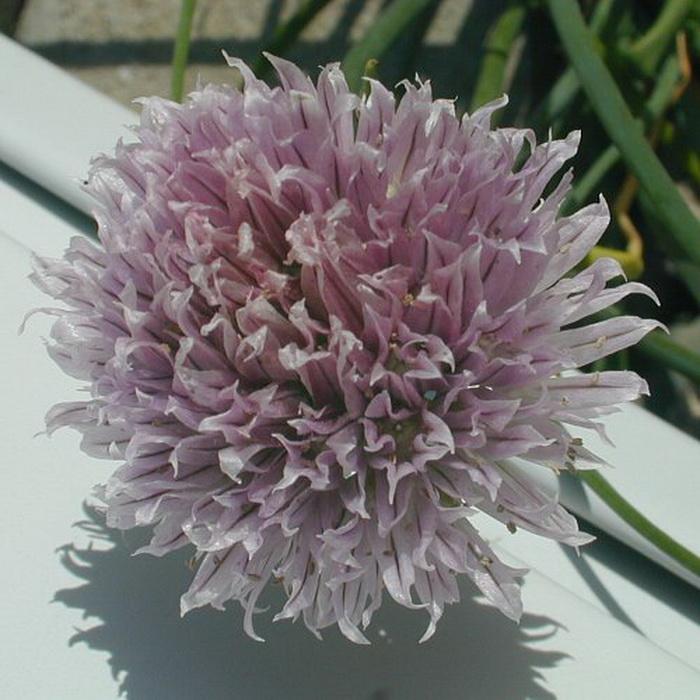
Photographic Location: Along a sidewalk at the webmaster's apartment complex. This plant was established from seed that had blown across the sidewalk from a neighboring pot of herbs.
Comments: The chopped leaves of Chives has a mild onion flavor that can be used to season various dishes and sauces, including salads and sour cream. The umbels of flowers are also edible if they are picked while they are still young; like the leaves, they have an onion flavor. This plant is rich a source of antioxidants, especially the leaves (Stajner et al., 2004). It also contains significant amounts of Vitamin A (as beta-carotene), folic acid, Vitamin C, Vitamin K, protein, and other nutrients. Chives (Allium schoenoprasum) is fairly easy to distinguish from other Allium spp. cause of its dense umbels of flowers and dense tufts of very narrow leaves. The umbels of other Allium spp. are typically more loose and there are conspicuous gaps between their flowers. The basal leaves of other Allium spp. are either solid and flattened or they are more terete and hollow. If they are the latter, then they are somewhat broader in circumference at their bases than the leaves of chives. Chives doesn't produce aerial bulblets, whereas Allium vineale (Field Garlic), Allium canadense (Wild Garlic), and some cultivated Allium spp. almost always do. Two varieties of Chives are sometimes described: the typical variety and var. sibiricum. The latter tends to be a taller and more robust plant, otherwise these two varieties are very similar to each other and they have a tendency to intergrade.
Cultivation: The preference is full or partial sun, moist to mesic conditions, and a fertile loamy soil. Chives is winter-hardy and easy to cultivate.
Range & Habitat: As a wild plant, Chives has naturalized in only a few counties of Illinois (see Distribution Map), where it is uncommon. While it is native to boreal areas of both Eurasia and North America, Chives was introduced into Illinois as a culinary herb. It is still commonly cultivated in gardens, from where this plant occasionally escapes. Habitats include grassy areas along railroads and roadsides, areas that are adjacent to gardens, weedy meadows, banks of streams, and waste areas. Habitats with a history of disturbance are preferred. Chives is less aggressive than either Allium vineale (Field Garlic) and Allium canadense (Wild Garlic).
Faunal Association: The nectar and pollen of the flowers attract small bees and flower flies primarily. Some insect species are known to feed destructively on Chives (Allium schoenoprasum) and other Allium spp. Insects that feed on the foliage and/or flowers include Thrips tabaci (Onion Thrips), Myzus ascalonicus (Shallot Aphid), Neotoxoptera formosa (Onion Aphid), Lindbergocapsus allii (Onion Plant Bug), and Lindbergocapsus ainsliei; see Marshall (2006), Blackman & Eastop (2013), Knight (1941), and Henry (1982). The larvae of several insects also feed on the bulbs of these plants, including Strigoderma arbicola (False Japanese Beetle), Delia antiqua (Onion Maggot), Tritoxa flexa (Black Onion Fly), Eumerus strigatus (Onion Bulb Fly), and Eumerus tuberculatus (Lesser Onion Bulb Fly). Mammalian herbivores usually avoid consumption of the foliage of Chives and other Allium spp., although it is occasionally consumed by White-tailed Deer and domesticated cattle (Sotala & Kirkpatrick, 1973; Georgia, 1913), especially during the spring when little else is available. When dairy cattle consume these plants, this taints the flavor of milk that they produce.

Photographic Location: Along a sidewalk at the webmaster's apartment complex. This plant was established from seed that had blown across the sidewalk from a neighboring pot of herbs.
Comments: The chopped leaves of Chives has a mild onion flavor that can be used to season various dishes and sauces, including salads and sour cream. The umbels of flowers are also edible if they are picked while they are still young; like the leaves, they have an onion flavor. This plant is rich a source of antioxidants, especially the leaves (Stajner et al., 2004). It also contains significant amounts of Vitamin A (as beta-carotene), folic acid, Vitamin C, Vitamin K, protein, and other nutrients. Chives (Allium schoenoprasum) is fairly easy to distinguish from other Allium spp. cause of its dense umbels of flowers and dense tufts of very narrow leaves. The umbels of other Allium spp. are typically more loose and there are conspicuous gaps between their flowers. The basal leaves of other Allium spp. are either solid and flattened or they are more terete and hollow. If they are the latter, then they are somewhat broader in circumference at their bases than the leaves of chives. Chives doesn't produce aerial bulblets, whereas Allium vineale (Field Garlic), Allium canadense (Wild Garlic), and some cultivated Allium spp. almost always do. Two varieties of Chives are sometimes described: the typical variety and var. sibiricum. The latter tends to be a taller and more robust plant, otherwise these two varieties are very similar to each other and they have a tendency to intergrade.
0
0
文章
Miss Chen
2018年07月08日

Description: This herbaceous perennial plant is 1-2½' tall, consisting of basal leaves and flowering stalks with alternate leaves. The stalks are light green and glabrous. The basal and lower leaves are bipinnate with 6-9 leaflets, while the upper leaves are pinnate with 3 leaflets. When the leaves are bipinnate, they are ternately divided into 3 groups of leaflets (2 lateral groups & a terminal group); each group has 2-3 leaflets. The leaflets of basal and lower leaves are 2-3" long and 1¼-2" across; they are medium to dark green, more or less ovate in shape, serrate or doubly serrate along their margins, and hairless or nearly so. Some leaflets may be deeply cleft into two lobes. The leaflets of upper leaves are smaller in size and more narrow in shape (lanceolate or oblong-lanceolate), otherwise they are similar to the leaflets of the preceding leaves. The petioles of basal and lower leaves are 4-12" long, while the petioles of upper leaves are less than 4" long. These petioles are light green and hairless; the petioles of alternate leaves are sheathed at their bases. The petiolule (basal stalklet) of the terminal group of leaflets is 2-3" long, while the petiolules of the lateral groups of leaflets are about 1" long. In each group of leaflets, the lateral leaflets are sessile or nearly so, while the terminal leaflet has a secondary basal stalklet that is nearly sessile to 1" long.
The stalks terminate in compound umbels of flowers about 1½-3½" across that are flat-topped. Each compound umbel is divided into 10-20 umbellets, while each umbellet is divided into 10-25 flowers. The compound umbels lack floral bracts and the umbellets lack floral bractlets. Individual flowers are about 1/8" (3 mm.) across, consisting of 5 white petals with incurved tips and an inferior ovary with a pair of styles. The peduncles of the compound umbels are 3-6" long, light green, glabrous, angular, and grooved. The pedicels of individual flowers are about ¼" in length, light green, and glabrous. The blooming period occurs from late spring to mid-summer, lasting about 1 month. The flowers are replaced by ovoid-oblongoid fruits that are ridged and somewhat flattened; they are about 1/8" (3 mm.) long and release their seeds at maturity during the autumn. The root system is fibrous and rhizomatous. Goutweed often forms clonal colonies from the spreading rhizomes.

Cultivation: The preference is partial sun to light shade, moist to mesic conditions, and soil containing loam, clay-loam, or sandy loam. This plant has few problems with either insects or disease organisms. It can spread aggressively, particularly in locales with cool moist climates.

Range & Habitat: So far, Goutweed has rarely escaped from cultivation and become naturalized in Illinois. It has been found as an escaped plant in only a few counties of NE Illinois (see Distribution Map). Because of its aggressive nature, Goutweed may become more common in the future. It was introduced into North America from Eurasia as an ornamental plant. Habitats include deciduous woodlands (sandy & non-sandy), shaded ravines, woodland borders, cemeteries, roadsides, and waste areas. Cultivated forms of Goutweed include those with variegated and non-variegated leaves. However, wild specimens of Goutweed almost always have non-variegated leaves.
Faunal Associations: Floral-faunal relationships for this plant in North America are poorly understood. Müller (1873/1883) observed miscellaneous flies, beetles, wasps, small bees, and sawflies visiting the flowers for either nectar or pollen in Germany. Apparently the young foliage of Goutweed is considered edible to humans as it has been used in the Old World as a source of food and a medicinal herb.

Photographic Location: A flower garden in Urbana, Illinois.
Comments: Like many other species in the Carrot family, Goutweed has compound umbels of small white flowers and compound leaves. It can be identified by the absence of floral bracts and bractlets underneath its flowers, and by the structure and shape of its leaves. Generally, its compound leaves have ternately arranged leaflets (divided into groups of 3), although the leaflets within a group sometimes occur in pairs. Compared with many other species in the Carrot family, these leaflets are relatively large in size and relatively broad in shape when one considers the size of the plant. Among native wildflowers, Honewort (Cryptotaenia canadensis) is similar in appearance to Goutweed, but the flowers of Honewort are even smaller in size and its compound leaves have only 3 leaflets, rather than 3 groups of leaflets.
The stalks terminate in compound umbels of flowers about 1½-3½" across that are flat-topped. Each compound umbel is divided into 10-20 umbellets, while each umbellet is divided into 10-25 flowers. The compound umbels lack floral bracts and the umbellets lack floral bractlets. Individual flowers are about 1/8" (3 mm.) across, consisting of 5 white petals with incurved tips and an inferior ovary with a pair of styles. The peduncles of the compound umbels are 3-6" long, light green, glabrous, angular, and grooved. The pedicels of individual flowers are about ¼" in length, light green, and glabrous. The blooming period occurs from late spring to mid-summer, lasting about 1 month. The flowers are replaced by ovoid-oblongoid fruits that are ridged and somewhat flattened; they are about 1/8" (3 mm.) long and release their seeds at maturity during the autumn. The root system is fibrous and rhizomatous. Goutweed often forms clonal colonies from the spreading rhizomes.

Cultivation: The preference is partial sun to light shade, moist to mesic conditions, and soil containing loam, clay-loam, or sandy loam. This plant has few problems with either insects or disease organisms. It can spread aggressively, particularly in locales with cool moist climates.

Range & Habitat: So far, Goutweed has rarely escaped from cultivation and become naturalized in Illinois. It has been found as an escaped plant in only a few counties of NE Illinois (see Distribution Map). Because of its aggressive nature, Goutweed may become more common in the future. It was introduced into North America from Eurasia as an ornamental plant. Habitats include deciduous woodlands (sandy & non-sandy), shaded ravines, woodland borders, cemeteries, roadsides, and waste areas. Cultivated forms of Goutweed include those with variegated and non-variegated leaves. However, wild specimens of Goutweed almost always have non-variegated leaves.
Faunal Associations: Floral-faunal relationships for this plant in North America are poorly understood. Müller (1873/1883) observed miscellaneous flies, beetles, wasps, small bees, and sawflies visiting the flowers for either nectar or pollen in Germany. Apparently the young foliage of Goutweed is considered edible to humans as it has been used in the Old World as a source of food and a medicinal herb.

Photographic Location: A flower garden in Urbana, Illinois.
Comments: Like many other species in the Carrot family, Goutweed has compound umbels of small white flowers and compound leaves. It can be identified by the absence of floral bracts and bractlets underneath its flowers, and by the structure and shape of its leaves. Generally, its compound leaves have ternately arranged leaflets (divided into groups of 3), although the leaflets within a group sometimes occur in pairs. Compared with many other species in the Carrot family, these leaflets are relatively large in size and relatively broad in shape when one considers the size of the plant. Among native wildflowers, Honewort (Cryptotaenia canadensis) is similar in appearance to Goutweed, but the flowers of Honewort are even smaller in size and its compound leaves have only 3 leaflets, rather than 3 groups of leaflets.
0
0
文章
Miss Chen
2018年07月06日

Onions are ideally suited for container gardening. Even a 6- to 10-inch container is large enough to get started, and can fit easily on a balcony or doorstep. Growing onions in containers is a perfect solution for space-challenged gardeners. As an added bonus, container gardening is easy on sore knees and backs as very little bending and stooping is required. Plant onions in spring and in a few weeks you'll have fresh, delicious onions.

Step 1
Purchase onion sets at a nursery or garden center. Sets, which are small onions that were started the previous year, are the easiest and most effective way of planting onions in containers. Small sets, which are smaller than a dime, are best for growing large onions for use in cooking or for slicing. Sets larger than a dime are best for growing small green onions often used in salads, and will be ready for harvest very quickly. Sets can be planted in March or April.
Step 2
Prepare a container at least 6 to 10 inches in diameter. Any container with drainage holes in the bottom will work. Fill the container with any good quality commercial potting soil.
Step 3
Plant large onion sets about 1 inch below the surface of the soil. Plant the sets close enough to touch, as the green onions will be harvested before crowding becomes problematic. Small sets, which will be used for large, dry onions, should be planted with 2 to 4 inches between each set.
Step 4
Water the onions immediately. Check the moisture daily by poking your finger into the top of the soil. If the top inch of the soil is dry, water the onions until water runs through the drainage hole. Don't water again until the top inch of the soil is dry. During hot, dry weather, onions may need water every day.
Step 5
Fertilize the onions two to four weeks after planting and repeat every two to three weeks. Use a regular water-soluble fertilizer applied according to the directions on the package. Alternatively, use a time-release granular fertilizer that can be mixed into the soil at planting time.
Step 6
Begin harvesting green onions when the tops are at least 6 inches tall. Green onions are best harvested when they are small, as the onions will develop a stronger flavor as they get larger.

Step 7
Harvest large onions in July or August when the tops of the plants begin to fall over. Harvest in the morning and lay the onions on top of the soil to dry until afternoon. Braid the tops of the onions in bunches of six to eight onions and hang the bunches in a warm, dry place to dry for two to three weeks

Step 1
Purchase onion sets at a nursery or garden center. Sets, which are small onions that were started the previous year, are the easiest and most effective way of planting onions in containers. Small sets, which are smaller than a dime, are best for growing large onions for use in cooking or for slicing. Sets larger than a dime are best for growing small green onions often used in salads, and will be ready for harvest very quickly. Sets can be planted in March or April.
Step 2
Prepare a container at least 6 to 10 inches in diameter. Any container with drainage holes in the bottom will work. Fill the container with any good quality commercial potting soil.
Step 3
Plant large onion sets about 1 inch below the surface of the soil. Plant the sets close enough to touch, as the green onions will be harvested before crowding becomes problematic. Small sets, which will be used for large, dry onions, should be planted with 2 to 4 inches between each set.
Step 4
Water the onions immediately. Check the moisture daily by poking your finger into the top of the soil. If the top inch of the soil is dry, water the onions until water runs through the drainage hole. Don't water again until the top inch of the soil is dry. During hot, dry weather, onions may need water every day.
Step 5
Fertilize the onions two to four weeks after planting and repeat every two to three weeks. Use a regular water-soluble fertilizer applied according to the directions on the package. Alternatively, use a time-release granular fertilizer that can be mixed into the soil at planting time.
Step 6
Begin harvesting green onions when the tops are at least 6 inches tall. Green onions are best harvested when they are small, as the onions will develop a stronger flavor as they get larger.

Step 7
Harvest large onions in July or August when the tops of the plants begin to fall over. Harvest in the morning and lay the onions on top of the soil to dry until afternoon. Braid the tops of the onions in bunches of six to eight onions and hang the bunches in a warm, dry place to dry for two to three weeks
0
0
成长记
choya8684
2018年07月04日

6/23不小心把虹之玉錦打翻就乾脆合盆了,虹之玉真的超容易曬傷曬乾,然後稍微給點水又果凍(葉孵母葉)。虹之玉錦反而比較耐曬又長得快,葉孵率百分百也不果凍


0
0
文章
Miss Chen
2018年07月03日

Description: This perennial wildflower is about 1-2' tall. It is unbranched, except near the apex, where the flowerheads occur. The central stem is pale green and more or less covered with white cobwebby hairs. The alternate leaves are up to 6" long and 1" across, becoming slightly smaller as they ascend the stems. Each fern-like leaf is pale to medium green, elliptic in outline, and widest in the middle – however, its structure is either simple-pinnate or double-pinnate and its overlapping leaflets are either simple-pinnate or pinnatifid. The leaves and sometimes their leaflets (when they are simple-pinnate) are upward-angled along their rachises (central stalks), while pinnatifid leaflets and subleaflets are either curled, crinkled, or flat. Like the stems, the leaves and their subdivisions often have fine cobwebby hairs. The leaves are sessile.
The upper stems produce flat-headed panicles (compound corymbs) of small flowerheads. Each flowerhead is about ¼" across, consisting of 5 ray florets (their petaloid rays are white, rarely rose or other pastel colors) and a similar number of disk florets that have cream or pale yellow corollas. The petaloid rays are often slightly notched at their tips. The floral bracts (phyllaries) are pale green and lanceolate-oblong; they often have cobwebby hairs. All parts of this plant exude a distinctive aroma that is somewhat soapy and astringent. The blooming period occurs from early to mid-summer and lasts about a month. Each floret is replaced by an achene that is oblong and somewhat flattened; it lacks a tuft of hairs. The root system produces abundant rhizomes, often forming clonal colonies of plants.

Cultivation: The preference is full or partial sun, mesic to dry conditions, and a somewhat heavy clay-loam soil.
Range & Habitat: Yarrow is a common plant that has naturalized in all counties of Illinois (see Distribution Map). The variety of Yarrow that occurs in Illinois is probably native to Eurasia, although there is a variety of this plant that is native to western North America. This latter variety tends to be smaller in size and its foliage is more heavily covered with woolly hairs. Habitats include mesic to dry prairies, pastures, fallow fields, grassy waste areas, and edges of paths, yards, or hedges. Disturbed areas are preferred; Yarrow persists in native habitats (e.g., prairies) to a limited extent. Yarrow is often cultivated in flower and herbal gardens, from where it occasionally escapes.

Faunal Associations: The nectar of the flowers attracts many kinds of insects, especially flies and wasps. Among the flies are such visitors as bee flies, Syrphid flies (including drone flies), thick-headed flies, Tachinid flies, flesh flies, Anthomyiid flies, and others. Halictid and other short-tongued bees occasionally visitor the flowers, where they suck nectar and collect pollen. Many species of grasshoppers feed on Yarrow (see Grasshopper Table), as do several aphids, a seed bug, a flower thrips, leaf beetles, and caterpillars of some moths (see Insect Table). Sometimes Mordella spp. (Tumbling Flower Beetles) are found on the flowerheads. Because the foliage of Yarrow has a bitter and biting taste, it is rarely consumed by most mammalian herbivores. However, sheep will eat it when the opportunity arises.

Photographic Location: Judge Webber Park and Meadowbrook Park in Urbana, Illinois.
Comments: Among members of the Aster family, the fern-like foliage of Yarrow is rather unusual and it has a distinctive odor. Other members of the Aster family with this kind of foliage include Anthemis spp. (Mayweed), Matricaria spp. (Chamomile), and Tanacetum vulgare (Tansy). Unlike Yarrow, species of Mayweed and Chamomile produce daisy-like flowerheads with long petaloid rays. Tansy is a larger plant with medium to dark green foliage. While its flowerheads have a similar size and structure as compared to those of Yarrow, they are bright yellow and their petaloid rays are even smaller in size or absent.
The upper stems produce flat-headed panicles (compound corymbs) of small flowerheads. Each flowerhead is about ¼" across, consisting of 5 ray florets (their petaloid rays are white, rarely rose or other pastel colors) and a similar number of disk florets that have cream or pale yellow corollas. The petaloid rays are often slightly notched at their tips. The floral bracts (phyllaries) are pale green and lanceolate-oblong; they often have cobwebby hairs. All parts of this plant exude a distinctive aroma that is somewhat soapy and astringent. The blooming period occurs from early to mid-summer and lasts about a month. Each floret is replaced by an achene that is oblong and somewhat flattened; it lacks a tuft of hairs. The root system produces abundant rhizomes, often forming clonal colonies of plants.

Cultivation: The preference is full or partial sun, mesic to dry conditions, and a somewhat heavy clay-loam soil.
Range & Habitat: Yarrow is a common plant that has naturalized in all counties of Illinois (see Distribution Map). The variety of Yarrow that occurs in Illinois is probably native to Eurasia, although there is a variety of this plant that is native to western North America. This latter variety tends to be smaller in size and its foliage is more heavily covered with woolly hairs. Habitats include mesic to dry prairies, pastures, fallow fields, grassy waste areas, and edges of paths, yards, or hedges. Disturbed areas are preferred; Yarrow persists in native habitats (e.g., prairies) to a limited extent. Yarrow is often cultivated in flower and herbal gardens, from where it occasionally escapes.

Faunal Associations: The nectar of the flowers attracts many kinds of insects, especially flies and wasps. Among the flies are such visitors as bee flies, Syrphid flies (including drone flies), thick-headed flies, Tachinid flies, flesh flies, Anthomyiid flies, and others. Halictid and other short-tongued bees occasionally visitor the flowers, where they suck nectar and collect pollen. Many species of grasshoppers feed on Yarrow (see Grasshopper Table), as do several aphids, a seed bug, a flower thrips, leaf beetles, and caterpillars of some moths (see Insect Table). Sometimes Mordella spp. (Tumbling Flower Beetles) are found on the flowerheads. Because the foliage of Yarrow has a bitter and biting taste, it is rarely consumed by most mammalian herbivores. However, sheep will eat it when the opportunity arises.

Photographic Location: Judge Webber Park and Meadowbrook Park in Urbana, Illinois.
Comments: Among members of the Aster family, the fern-like foliage of Yarrow is rather unusual and it has a distinctive odor. Other members of the Aster family with this kind of foliage include Anthemis spp. (Mayweed), Matricaria spp. (Chamomile), and Tanacetum vulgare (Tansy). Unlike Yarrow, species of Mayweed and Chamomile produce daisy-like flowerheads with long petaloid rays. Tansy is a larger plant with medium to dark green foliage. While its flowerheads have a similar size and structure as compared to those of Yarrow, they are bright yellow and their petaloid rays are even smaller in size or absent.
0
0
文章
Miss Chen
2018年06月28日


6.Graptoveria 'Topsy Debbie'
Graptopetalums like 'Topsy Debbie' form rosettes of leaves that spread by offsets, which easily form new plants for your propagating pleasure. Plants must grow in full sun for best health and vigor.

7.Aloe hawthoroides
The classic aloe plant has gotten an update: Aloe hawthoroides has dozens of feathery bristles on each leaf, which are all bark but no bite. This touchable plant has a moderate growth habit and is tolerant of a wide variety of growing conditions, as long as you don't let it freeze or sit in stagnant water.

8.Kalanchoe rhombopilosa
Who can resist a plant called "pies from heaven?" This kalanchoe is but one of the many strange and beautiful living things that hails from Madagascar. The leaves are fuzzy, grey and covered with brown streaking. Insignificant yellow flowers may appear on stalks in the spring. Give your kalanchoe abundant light for healthy plants.
Continue to 9 of 10 below.

9.Echeveria gibbiflora 'Barbillion'
If you've ever observed the fleshy wattle of a turkey or rooster, you have seen something these fowl have in common with echeveria 'Barbillion:' they are both carunculated. This term refers to a bumpy, fleshy growth. Is it beautiful or hideous? Give it plenty of light and water sparingly, and see if the unusual appeal of this succulent grows on you.

10.Echeveria 'Blue Curls'
A single specimen of echeveria, 'Blue Curls' makes an exquisite statement in a container with its frilly leaves and pink and aqua coloration. Prevent water from accumulating within the rosette and remove dead leaves from the plant's base to keep pests from interfering with its vigor.
0
0
文章
Miss Chen
2018年06月27日

Description: This wildflower is a summer annual about 3-6' tall, branching frequently. The somewhat succulent stems are light green, glabrous, and glaucous. The alternate leaves are up to 4" long and 2" across. They are ovate, hairless, and serrated along the margins; their slender petioles are up to 2" long. From theClose-up of Flowers axils of the middle to upper leaves, short racemes of 1-3 flowers are produced. Each flower is about 1–1¼" long, consisting of 5 petals, 3 sepals, and reproductive organs within the tubular corolla. This corolla is yellow, or less often cream-colored, and consists of the fusion (or near fusion) of the 5 petals and lower sepal. The lower sepal is petaloid; it defines the conical posterior of the corolla, which tapers to a tiny nectar spur that curls downward. The upper petal defines the upper lip (or hood) of the corolla, while the two lower petals form a pair of well-rounded lobes that are rather irregular and wrinkled. Two small lateral petals define the sides of the corolla opening, although they are difficult to see when the flowers are viewed from above. There are usually reddish brown spots within the interior of the corolla, although they are sometimes absent. The upper 2 sepals are light green and ovate in shape; they are located at the top of the corolla, rather than behind or underneath. Each flower dangles from a slender pedicel about ¾" long. The blooming period occurs from mid-summer to early fall and lasts about 2-3 months. Each fertilized flower is replaced by an ellipsoid seedpod up to 2" long. This seedpod is broadest toward the middle, tapering toward its tips; it has several dark green lines along its length. As the seedpod ripens, it splits open and ejects the seeds. The root system consists of a shallow branching taproot.
Cultivation: The preference is partial sun, wet to moist conditions, and soil that is loamy or mucky. Yellow Jewelweed also tolerates full sun, light shade, and mesic conditions (if it receives some protection from the afternoon sun). This species is a little more tolerant of dry conditions than Impatiens capensis (Orange Jewelweed). It grows rapidly from seed during the summer and can achieve an impressive size.
Range & Habitat: The native Yellow Jewelweed occurs occasionally in central and northern Illinois; it is less common or absent in the southern portion of the state (see Distribution Map). Habitats include muddy borders along ponds and streams (especially in wooded areas), swamps, openings in moist deciduous woodlands, and soggy thickets. Sometimes this species is cultivated in gardens.

Faunal Associations: The nectar of the flowers attracts the Ruby-Throated Hummingbird and bumblebees; the latter are especially common visitors. The caterpillars of various moths feed on the foliage, including Euchlaena obtusaria (Obtuse Euchlaena), Spilosoma latipennis (Pink-Legged Tiger Moth), Trichodezia albovittata (White-Striped Black), and Xanthorhoe lacustrata (Toothed Brown Carpet). The large seeds are eaten by various gamebirds, including the Ruffed Grouse, Ring-Necked Pheasant, Greater Prairie Chicken, and Bobwhite Quail. The White-Footed Mouse also eats the seeds. White-Tail Deer browse on the foliage.
Photographic Location: The photographed plants were growing along the back alley of a residential area in Urbana, Illinois.
Comments: Yellow Jewelweed is closely related to the more common Impatiens capensis (Orange Jewelweed). It is very similar in appearance to the latter species, except that its flowers are yellow, rather than orange. The tubular corolla of Yellow Jewelweed is broader toward its posterior, and its 2 lower petals are divided at the base, rather than fused together. Both of these Jewelweeds have attractive foliage and large interesting flowers that bloom over an extended period of time.
Cultivation: The preference is partial sun, wet to moist conditions, and soil that is loamy or mucky. Yellow Jewelweed also tolerates full sun, light shade, and mesic conditions (if it receives some protection from the afternoon sun). This species is a little more tolerant of dry conditions than Impatiens capensis (Orange Jewelweed). It grows rapidly from seed during the summer and can achieve an impressive size.
Range & Habitat: The native Yellow Jewelweed occurs occasionally in central and northern Illinois; it is less common or absent in the southern portion of the state (see Distribution Map). Habitats include muddy borders along ponds and streams (especially in wooded areas), swamps, openings in moist deciduous woodlands, and soggy thickets. Sometimes this species is cultivated in gardens.

Faunal Associations: The nectar of the flowers attracts the Ruby-Throated Hummingbird and bumblebees; the latter are especially common visitors. The caterpillars of various moths feed on the foliage, including Euchlaena obtusaria (Obtuse Euchlaena), Spilosoma latipennis (Pink-Legged Tiger Moth), Trichodezia albovittata (White-Striped Black), and Xanthorhoe lacustrata (Toothed Brown Carpet). The large seeds are eaten by various gamebirds, including the Ruffed Grouse, Ring-Necked Pheasant, Greater Prairie Chicken, and Bobwhite Quail. The White-Footed Mouse also eats the seeds. White-Tail Deer browse on the foliage.
Photographic Location: The photographed plants were growing along the back alley of a residential area in Urbana, Illinois.
Comments: Yellow Jewelweed is closely related to the more common Impatiens capensis (Orange Jewelweed). It is very similar in appearance to the latter species, except that its flowers are yellow, rather than orange. The tubular corolla of Yellow Jewelweed is broader toward its posterior, and its 2 lower petals are divided at the base, rather than fused together. Both of these Jewelweeds have attractive foliage and large interesting flowers that bloom over an extended period of time.
0
0



